There are around 7,000 frog species across the world, living across a wide range of different habitats. Towards the equator in more tropical climates these frogs don’t have to worry about winter, but in temperate and Arctic regions freezing temperatures can result in frogs succumbing to the cold.
Many people will assume frogs simply die during the winter, as they no longer see them. Yet frogs, like many species, have adapted incredible survival techniques in order to get through the winter, all centered around hibernation.
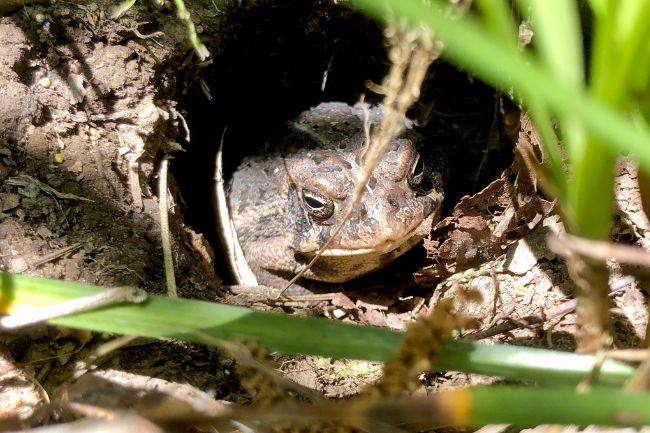
The Hibernation of Frogs
Hibernation is often thought of as a kind of deep sleep that allows animals to sit out the winter. Bears are well-known for hibernating during the winter, but few people realize that frogs also hibernate.
Hibernation is a state that animals enter when conditions become too cold for them to survive, or food becomes scarce. During hibernation the animal’s heartbeat slows, as does their breathing. This allows their temperature and metabolic rate to fall.
All of this means that they require less food and water and can cope with lower temperatures. In this state the animal may still get up and move around occasionally as they dip in and out of their torpid state.
In frogs, hibernation takes place as weather conditions become too cold for them to survive. Aquatic species often spend their hibernation at the bottom of ponds. Unlike some species they don’t bury themselves in the mud, simply remaining on its surface.
| Frog Species | Hibernation | Freeze Tolerance | Supercooling | Additional Information |
|---|---|---|---|---|
| Wood Frog | Yes | No | No | Can tolerate partial freezing and revive when temperatures rise |
| Spring Peeper | Yes | No | No | Can withstand freezing temperatures by entering a state of deep hibernation |
| Gray Tree Frog | Yes | Yes | No | Can tolerate freezing by producing high concentrations of glucose |
| American Bullfrog | No | No | Yes | Can supercool their body fluids to temperatures below freezing |
Most land species shelter from the cold in one of two ways. Either they dig down into the soil beyond the frost line, or they head into cracks or hollows in rocks or trees, and take shelter there.
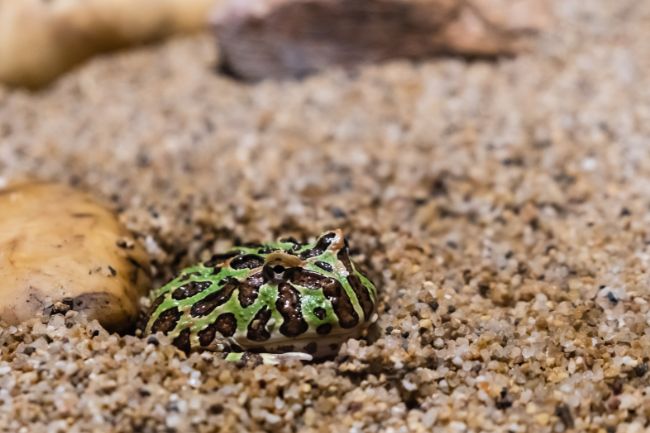
Like other species, going into a hibernation state means their heart rate slows and their metabolic rate decreases. Many frogs also close their eyes using their third eyelid, the nictitating membrane. This is slightly transparent, allowing them to see potential predators.
Adaptations for Winter Survival
It may surprise many people that frogs can spend many months at the bottom of a pond. This is all down to an amazing adaptation in frogs that allows them to breathe through their skin.
It’s because of this need to breathe that frogs don’t bury themselves in the mud, as there won’t be enough oxygen there for them to survive. Depending on the oxygen availability frogs may also swim around during their hibernation, in order to access enough oxygen to survive.
Sheltering at the bottom of the pond can be a practical way to escape the cold, as if the surface of the pond freezes over the water underneath will be relatively insulated from the falling temperatures.
| Adaptation | Description | Additional Information |
|---|---|---|
| Freeze Tolerance | Some frogs can survive freezing temperatures by producing antifreeze compounds that protect their cells. | Antifreeze compounds prevent ice crystal formation and damage to cells |
| Hibernation | Many frog species go into a state of hibernation during winter, slowing down their metabolism. | Metabolic processes slow down, conserving energy and allowing survival during winter |
| Supercooling | Certain frogs can lower their body temperature without freezing, enabling them to remain active. | They can remain active at near-freezing temperatures without forming ice |
Also read: Here’s “How Frogs Find Ponds”
As the temperature falls frogs are able to fill their cells with glucose. These sugars act as stuffing, preventing the cell from being damaged as ice crystals grow within them. Nucleating proteins also ensure the water in the frog’s blood freezes first, pulling water out of surrounding cells.
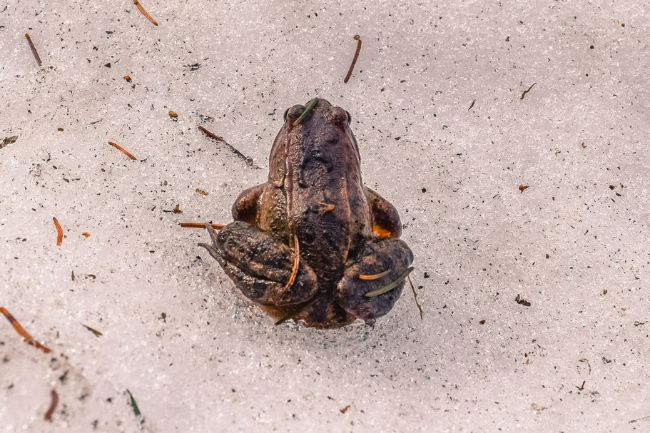
All this means that the frog can completely freeze, no longer breathing and its heart stopping. And when the thaw comes the frog simply defrosts, its heart starting up again, and within a short time, it can hop away and get on with its day.
There are very few animals on earth that can survive a complete freeze without dying. A truly remarkable winter survival technique.
Food and Water Sources
One of the reasons frogs enter hibernation in winter is the lack of food. For most frogs food will be small insects or molluscs, such as slugs and snails, flies and mosquitos.
As these invertebrates are cold-blooded, winter is a treacherous time for them. Some species will migrate to avoid winter, others enter diapause (the invertebrate equivalent of hibernation) and large numbers will even admit defeat and die off, leaving a younger generation to emerge the following year.
| Frog Species | Preferred Winter Habitat | Winter Behavior | Additional Information |
|---|---|---|---|
| Leopard Frog | Bottom of ponds and lakes | Burrowing into mud or leaf litter to hide and conserve energy | Can absorb oxygen through their skin while buried in mud or leaf litter |
| Green Frog | Marshes and wetlands | Seeking shelter in submerged vegetation or mud | Can remain partially submerged in water to avoid freezing temperatures |
| Pickerel Frog | Woodlands and forest edges | Hiding under logs, rocks, or leaf litter | Camouflage allows them to blend with their surroundings and avoid predators |
With their prey gone, hiding or dead, most frogs have no choice but to enter hibernation until food is available once more.
Water is often less of a problem unless all sources are frozen. Frogs don’t drink water with their mouths, instead absorbing it through their skin, meaning they can take in water from puddles that they sit in.
Lack of water can also be a reason to hibernate. In areas where dry seasons are common some frogs estivate, which is hibernation caused by lack of water availability. Like hibernation they will burrow down and wait for conditions to improve.
Some frogs have even developed the ability to shed layers of their skin, creating a kind of cocoon, within which they can be safe from the dry conditions.
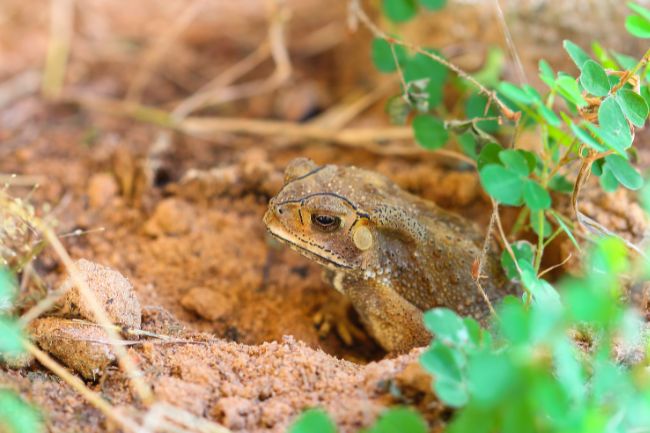
Also read: Frogs in a Pond: What Do They Eat?
Threats to Frog Survival in Winter
While frog species have found ingenious ways to keep safe over the winter months, there’s still plenty of dangers during this treacherous time.
One key issue during this time can be predation. Not all animals hibernate during the winter. Those that remain active have to search for food to survive. In the cold weather, frogs will be less reactive to danger. If found by a predator, the frogs won’t have much ability to escape.
Changing climates can be another risk for frog species, as with many animals that hibernate. As weather conditions become less reliable, many countries are experiencing warm periods during normally cold winters. In these warm periods, frogs may awake from hibernation. Having become active they will need to eat or they could starve, however often there will be no prey species for them to eat.
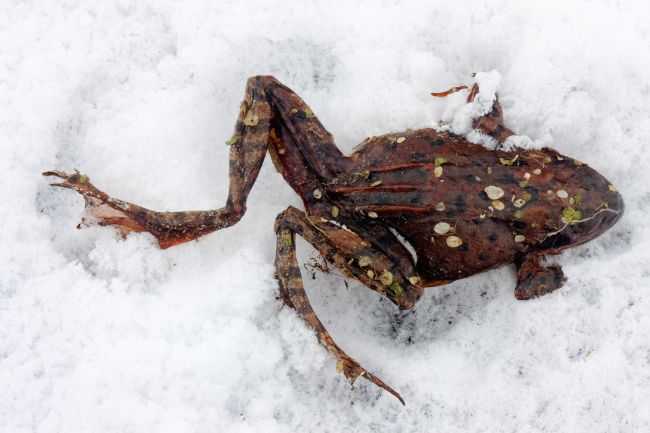
Conclusion
It is amazing to think of an animal being frozen solid and then simply defrosting and getting on with its day. Such abilities would seem superhuman to us, but are just part of an annual cycle for many frogs.
Whether they hibernate to last out the winter or estivate to get through a drought, frogs have found when the conditions get tough it’s sometimes simply best to wait it out.
But as climate change effects weather patterns across the world, frogs are at risk of finding their winters unpredictable. For many wild animals, worse than bad weather is unpredictable weather.

